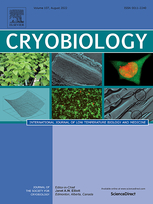
Thermodynamic aspects of vitrification.
Author(s) : WOWK B.
Type of article: Article, Review
Summary
Vitrification is a process in which a liquid begins to behave as a solid during cooling without any substantial change in molecular arrangement or thermodynamic state variables. The physical phenomenon of vitrification is relevant to both cryopreservation by freezing, in which cells survive in glass between ice crystals, and cryopreservation by vitrification in which a whole sample is vitrified. The change from liquid to solid behaviour is called the glass transition. It is coincident with liquid viscosity reaching 1013 Poise during cooling, which corresponds to a shear stress relaxation time of several minutes. The glass transition can be understood on a molecular level as a loss of rotational and translational degrees of freedom over a particular measurement timescale, leaving only bond vibration within a fixed molecular structure. Reduced freedom of molecular movement results in decreased heat capacity and thermal expansivity in glass relative to the liquid state. In cryoprotectant solutions, the change from liquid to solid properties happens over a 10°C temperature interval centered on a glass transition temperature, typically near -120°C (plus or minus 10°C) for solutions used for vitrification. Loss of freedom to quickly rearrange molecular position causes liquids to depart from thermodynamic equilibrium as they turn into a glass during vitrification. Residual molecular mobility below the glass transition temperature allows glass to very slowly contract, release heat, and decrease entropy during relaxation toward equilibrium. Although diffusion is practically non-existent below the glass transition temperature, small local movements of molecules related to relaxation have consequences for cryobiology. In particular, ice nucleation in supercooled vitrification solutions occurs at remarkable speed until at least 15°C below the glass transition temperature. [Reprinted with permission from Elsevier. Copyright, 2009].
Details
- Original title: Thermodynamic aspects of vitrification.
- Record ID : 2010-1659
- Languages: English
- Source: Cryobiology - vol. 60 - n. 1
- Publication date: 2010/02
- DOI: http://dx.doi.org/10.1016/j.cryobiol.2009.05.007
Links
See the source
Indexing
- Themes: Cryomedicine and cryosurgery
- Keywords: Vitrification; Thermodynamics; Glass transition; Equilibrium; Review; Stability; Solidification; Cryopreservation
-
Application of cryogenics in gynaecology.
- Author(s) : BUCKSHEE K., ABBI M.
- Date : 1996
- Languages : English
- Source: Indian J. Cryog. - vol. 21 - n. 2
View record
-
Coral larvae conservation: Physiology and repro...
- Author(s) : HAGEDORN M., PAN R., COX E. F., et al.
- Date : 2006/02
- Languages : English
- Source: Cryobiology - vol. 52 - n. 1
View record
-
Cryopreservation of biomaterials: preparation o...
- Author(s) : KAWAI K.
- Date : 2006/02
- Languages : Japanese
- Source: Refrigeration - vol. 81 - n. 940
View record
-
Cryoimmunology: Opportunities and challenges in...
- Author(s) : KORPAN N. N., GOLTSEV A. N., DRONOV O. I., BONDAROVYCH M. O.
- Date : 2021/06
- Languages : English
- Source: Cryobiology - vol. 100
- Formats : PDF
View record
-
The glass transition temperature of mixtures of...
- Author(s) : CHEN T., BHOWMICK S., SPUTTEK A., et al.
- Date : 2002/06
- Languages : English
- Source: Cryobiology - vol. 44 - n. 3
View record
